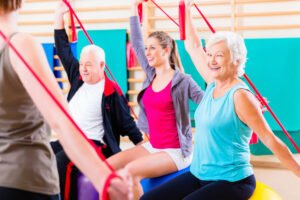Occupational therapists specialize in increasing the quality of life and independence of their clients – this includes people with Parkinson’s Disease (PD). As PD progresses, people can find themselves struggling with everyday tasks such as eating, walking, writing, or using their phone or computer. Leisure activities can also be affected such as golfing or painting.
At Balance in motion, all of our balance specialists are certified therapists who can safely and effectively create exercise plans for people with Parkinson’s Disease. Occupational therapists help people with PD maximize their movement through specific exercises as well as maximize their independence through adaptive equipment and individualized strategies.
Balance in Motion also provides community connections and recommendations for people with Parkinson’s Disease who are seeking more resources regarding their PD. For example, Parkinson Support and Wellness is right here in Cincinnati and has a plethora of resources including but not limited to support groups and educational tools.
Below are some basic strategies we may recommend for people struggling with Parkinson’s Disease symptoms.
Weight training
Weight bearing exercises, such as weight training, are beneficial as they can improve muscle strength, endurance, and balance. Weight training is especially beneficial for increasing independence with tasks or leisure activities that require gross motor skills such as golfing. Research shows that people with PD who consistently participate in weight training can improve symptoms of PD and in some cases slow the progression of the disease altogether!
Eating
Symptoms of PD can create many barriers surrounding eating. Decreased strength and increased tremors can make bringing food to mouth difficult while pain and decreased balance can interfere with meal preparation. There are countless options for adaptive equipment for PD on the market (recommendations will differ for each individual). Some common adaptive equipment recommendations are weighted utensils (to reduce tremors while maintaining grasp), built-up utensils (allows easier control and requires less grip strength), and stabilizing utensils (contain sensors that detect the force and direction of a tremor and move to counteract the tremor).
For meal preparation, we would recommend strategies such as rearranging items in the kitchen for easier or safer access. We also work with individuals to create a plan to decrease the amount of energy required for each task to ensure the person has the endurance to successfully complete the entirety of the task. This might look like completing meal preparation seated at the table, using adaptive equipment to stabilize food that needs to be cut, or sliding heavy pots of water or food along the countertop instead of carrying them.
Writing
Just like eating utensils, there are a lot of adaptive equipment options for writing utensils. For writing, hand exercises to build and maintain strength and flexibility is vital. Increasing hand strength is also beneficial for increasing independence with leisure activities that require fine motor skills such as sewing or painting. Another important aspect of increasing independence with writing is positioning. Modifying your sitting position or the angle of your writing surface can make all of the difference.
Cell Phone & Computer
Utilizing technology can be difficult for anyone that struggles with tremors or movement disorders. The screens are typically very small and the touch sensitivities are typically very high. To increase independence with technology we recommend two main strategies:
1.Enabling different accessibility settings on your device. This could look like setting up voice commands to open and navigate apps or speech to text options to replace texting on a phone or typing on a computer. There are also settings to decrease touch sensitivities including a setting that will ignore multiple touches (a common occurrence for people that experience tremors).
2. Buying adaptive equipment such as modified keyboards or specific software that can be installed to increase independence and accessibility.
Final Reminder
Each person with Parkinson’s Disease presents differently and experiences unique challenges. It is important to seek out a professional that can understand your specific needs and provide individualized recommendations. At Balance in Motion, all of our members receive personalized training from a skilled and professional therapist that specializes in aging.









